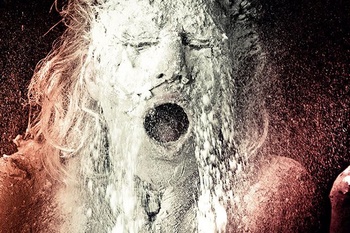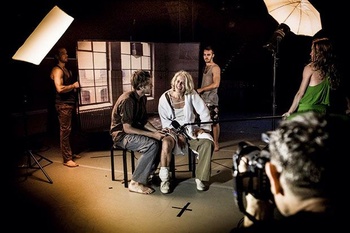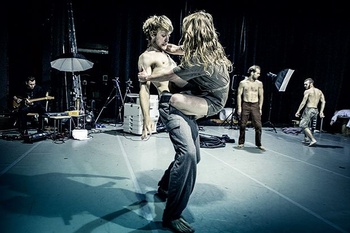(© Danny Willems)
In booty Looting, the choreographer Wim Vandekeybus places photography centre stage in order to dissect its mechanisms and its connections with memory. In what way is a photograph a proof, a trace? What is true in it? What is false? We also meet an infanticidal (via a photocopier) Medea and the German artist Joseph Beuys.
The cast of booty Looting is made up of six performers, a musician, and – which is rather unusual for a “dance” show – a photographer, Danny Willems. The new show sees the Belgian choreographer Wim Vandekeybus return to his first love, photography, which was already present in some touches in What the Body Does Not Remember, which launched his choreographic career back in 1987.
You use a photographer as a performer in this work. Why?
Wim Vandekeybus: The show’s starting point was to see what photography is and how it could be present onstage as an active medium and not just be something whose results you see in magazines or in a frame hanging on a wall. To see how photographs are made, how they can lie and tell a different story, and to see how the photographer can single out one element of a complex reality and draw attention to something that other people didn’t see.
Wim Vandekeybus: booty Looting the memory


(© Wim Vandekeybus)
And you picked Danny Willems.
Vandekeybus: He’s a longstanding friend. He is THE rock photographer in Belgium. For example, he has followed Arno’s entire career. Danny did the photographs of my first show, What the Body Does Not Remember, and he has followed my work over many years. When you watch a good photographer in action, that’s already choreography. Danny has the experience, the charisma, and a sensibility. He has no hesitation about disturbing the audience if he has to in order to take the photographs. He’s someone who is practically one with his camera. When he picks it up, it’s like a sheep that turns into a wolf. Whereas these days, one can take 100 photographs and just keep two, every photograph that Danny takes is projected onto a screen on the stage. There are fifty photographs and you see them all.
“Booty looting” means stealing something that has already been stolen. How should we interpret that title?
Vandekeybus: I like putting words together that give me inspiration. “Booty looting”: “You steal and I steal from you.” Art is a bit like that. You don’t start from nowhere. We’re also undermining here the myth of the artist who “creates”. You have to practically take that word “artist” apart. That idea of stealing something is also linked to the photograph. Certain peoples didn’t want to have their photograph taken because they were afraid their souls were going to be stolen. It’s interesting too to observe that tourism began and boomed in parallel with the invention and the development of the camera. People didn’t go to see something: they went to bring home a photograph of that thing. Tourism is linked to that invention, which makes it possible to bring memories home. I don’t know where that’s going to end, with new technology, smartphones, and so on. Before, you photographed other people, whereas now it’s “me, me, me”. Everyone photographs themselves and nobody gives a damn about quality. People are looking for a confirmation of themselves: I exist and there are people who are glad I exist.
And you picked Danny Willems.
Vandekeybus: He’s a longstanding friend. He is THE rock photographer in Belgium. For example, he has followed Arno’s entire career. Danny did the photographs of my first show, What the Body Does Not Remember, and he has followed my work over many years. When you watch a good photographer in action, that’s already choreography. Danny has the experience, the charisma, and a sensibility. He has no hesitation about disturbing the audience if he has to in order to take the photographs. He’s someone who is practically one with his camera. When he picks it up, it’s like a sheep that turns into a wolf. Whereas these days, one can take 100 photographs and just keep two, every photograph that Danny takes is projected onto a screen on the stage. There are fifty photographs and you see them all.
“Booty looting” means stealing something that has already been stolen. How should we interpret that title?
Vandekeybus: I like putting words together that give me inspiration. “Booty looting”: “You steal and I steal from you.” Art is a bit like that. You don’t start from nowhere. We’re also undermining here the myth of the artist who “creates”. You have to practically take that word “artist” apart. That idea of stealing something is also linked to the photograph. Certain peoples didn’t want to have their photograph taken because they were afraid their souls were going to be stolen. It’s interesting too to observe that tourism began and boomed in parallel with the invention and the development of the camera. People didn’t go to see something: they went to bring home a photograph of that thing. Tourism is linked to that invention, which makes it possible to bring memories home. I don’t know where that’s going to end, with new technology, smartphones, and so on. Before, you photographed other people, whereas now it’s “me, me, me”. Everyone photographs themselves and nobody gives a damn about quality. People are looking for a confirmation of themselves: I exist and there are people who are glad I exist.

(© Danny Willems)
The show has at its heart Birgit Walter’s character. Is it a reconstruction of her life?
Vandekeybus: Through photography, we reconstruct her life, but exploring all possible scenarios. At times she’s an anthropologist, at times she’s an actress, at times an art collector... At least a third of what is said onstage is false. Which is often the way with art. As with the German artist Joseph Beuys. What’s true and what’s false in his life? He said he was a pilot in the Luftwaffe on the Russian front, although he had a phobia about heights. We recreate on stage his performance I Like America and America Likes Me [in which Joseph Beuys locked himself up for three days with a coyote in the René Block gallery in 1974 - ES].
You also look at the impact of photography on memory.
Vandekeybus: Photographs are time’s memory. If someone dies without ever having been photographed, there is no memory. You can also create fake memories on the basis of photographs.
The show has at its heart Birgit Walter’s character. Is it a reconstruction of her life?
Vandekeybus: Through photography, we reconstruct her life, but exploring all possible scenarios. At times she’s an anthropologist, at times she’s an actress, at times an art collector... At least a third of what is said onstage is false. Which is often the way with art. As with the German artist Joseph Beuys. What’s true and what’s false in his life? He said he was a pilot in the Luftwaffe on the Russian front, although he had a phobia about heights. We recreate on stage his performance I Like America and America Likes Me [in which Joseph Beuys locked himself up for three days with a coyote in the René Block gallery in 1974 - ES].
You also look at the impact of photography on memory.
Vandekeybus: Photographs are time’s memory. If someone dies without ever having been photographed, there is no memory. You can also create fake memories on the basis of photographs.
Remembering things you didn’t experience?
Vandekeybus: I have an anecdote about that. A man lost his father. Two years later, he meets a friend of his father’s again and thanks him for having been at the funeral; he tells him that it was a comfort to see him there that day. But the friend replies that he wasn’t there: he was travelling abroad at the time. That person had created that memory and had to dismantle it.
Onstage, there is not only a photographer, but also a photocopier.
Vandekeybus: When my children were little, we used to play at photocopying ourselves. It’s magical to pass like that from three to two dimensions. And then there is something restful about the result, perhaps because you have to close your eyes due to the light. It’s almost as if you were dying. In the show, Birgit becomes Medea, who kills her sons with the photocopier.
This is a show in which the audience has to play its part.
Vandekeybus: Plato said that the theatre is innocent people who go to see the suffering of others. For him, the passivity of the audience was something negative. In booty Looting, we construct, then we deconstruct. Not everything we say is true. Spectators who are used to classic structures may find that baffling. Here, the spectator has to make an effort.
BOOTY LOOTING • 23 > 26, 29 > 31/10, 20.00, €18/21/22/25, KVS_Bol, Lakensestraat 146 rue de Laeken, Brussel/Bruxelles, 02-210.11.12, www.kvs.be
Vandekeybus: I have an anecdote about that. A man lost his father. Two years later, he meets a friend of his father’s again and thanks him for having been at the funeral; he tells him that it was a comfort to see him there that day. But the friend replies that he wasn’t there: he was travelling abroad at the time. That person had created that memory and had to dismantle it.
Onstage, there is not only a photographer, but also a photocopier.
Vandekeybus: When my children were little, we used to play at photocopying ourselves. It’s magical to pass like that from three to two dimensions. And then there is something restful about the result, perhaps because you have to close your eyes due to the light. It’s almost as if you were dying. In the show, Birgit becomes Medea, who kills her sons with the photocopier.
This is a show in which the audience has to play its part.
Vandekeybus: Plato said that the theatre is innocent people who go to see the suffering of others. For him, the passivity of the audience was something negative. In booty Looting, we construct, then we deconstruct. Not everything we say is true. Spectators who are used to classic structures may find that baffling. Here, the spectator has to make an effort.
BOOTY LOOTING • 23 > 26, 29 > 31/10, 20.00, €18/21/22/25, KVS_Bol, Lakensestraat 146 rue de Laeken, Brussel/Bruxelles, 02-210.11.12, www.kvs.be
Read more about: Podium
Fijn dat je wil reageren. Wie reageert, gaat akkoord met onze huisregels. Hoe reageren via Disqus? Een woordje uitleg.